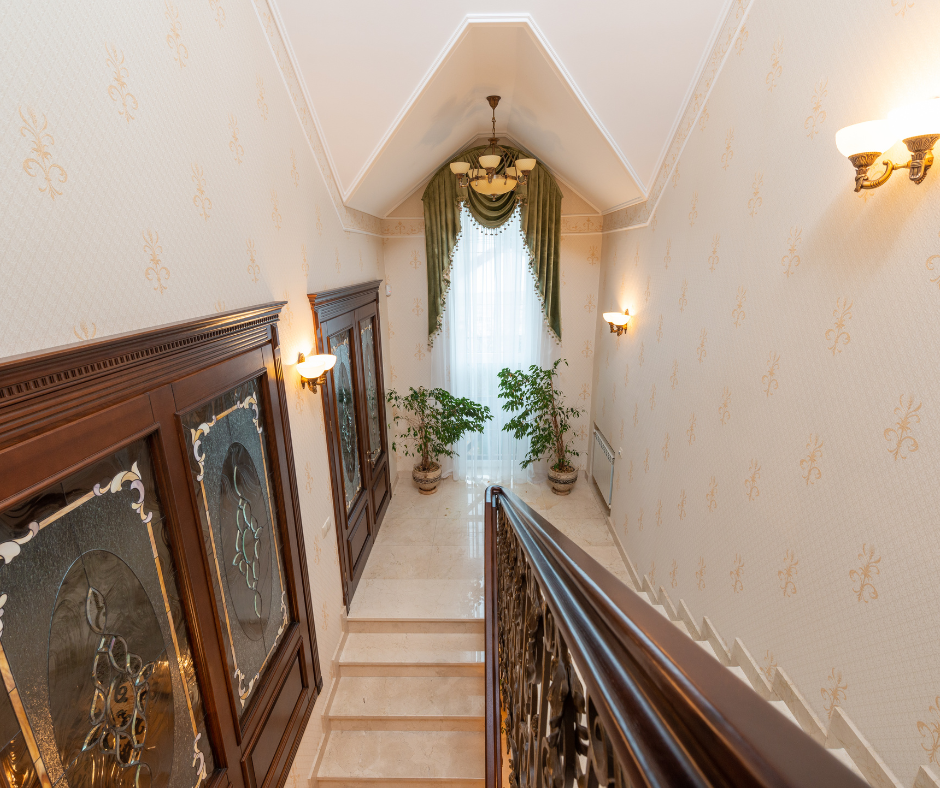Your staircase is one of the first things people see in your home—why not make it both safe and stunning?
A traditional stair railing is a timeless structure designed to provide safety, support, and style with features like handrails, balusters, and newel posts.
When paired with carpet stair treads, it becomes a complete solution for comfort, traction, and visual appeal.
In this guide, you’ll learn how each part of the railing system works and what makes it different from modern alternatives.
We’ll also cover simple ways to upgrade your staircase without losing its traditional charm.
Whether you're renovating or just refreshing, you'll walk away with practical tips that protect your family and elevate your space.
Why Traditional Railings Still Matter Today
In today’s world of sleek metal and modern glass, you might wonder why homeowners still choose traditional options.
The answer is simple.
They last.
They feel solid under your hand.
And they bring a sense of comfort and home that never goes out of style.
A traditional stair railing isn’t just about looks—it’s built with purpose.
It supports you.
It protects your family.
And it’s often made of rich, natural materials like hardwood, which only get better with age.
It fits beautifully into both historic homes and modern spaces with classic features.
And when you pair one with a traditional stair runner, the result is a staircase that feels warm, cozy, and safe underfoot—without losing its visual impact.
What is a Standard Railing?
A traditional stair railing is made up of multiple parts that work together to create both safety and style.
Here’s what makes up a standard railing:
-
Handrail – The part you hold as you climb or descend. It needs to be smooth, strong, and easy to grip.
-
Balusters – Vertical posts beneath the handrail. These keep kids, pets, and adults from falling over the edge.
-
Newel Posts – Larger, supportive posts at the top and bottom of the staircase. They ground the railing and give it strength.
-
Base Rail – The horizontal rail along the bottom that balusters connect into.
Each of these traditional stair parts is designed to fit together perfectly, like a well-crafted puzzle.
When built correctly, the whole system works to keep your stairs safe while complementing the style of your home.
What’s the Difference Between a Banister and a Railing?
These two terms are often used the same way, but they have slightly different meanings.
A banister usually refers to just the handrail and the posts holding it up—mostly what you can touch and see at the side of the staircase.
A railing, on the other hand, includes the full structure: handrail, balusters, base rail, and all the other elements that work together for safety and design.
Think of it like this: a banister is part of the whole picture, but the railing is the full frame.
Understanding the difference helps when you're picking out pieces or explaining what you want to update.
Bringing Traditional Style Into a Modern Home
You don’t have to live in a century-old house to enjoy the beauty of a traditional stair railing.
With a few smart design choices, you can bring classic charm into even the most modern space.
It’s about mixing textures, finishes, and lighting in a way that honors the old without ignoring the new.
Material Mixes
Start with a warm, natural wood railing, then introduce metal balusters or glass panels for a clean and open feel.
The combination adds contrast and keeps the space feeling fresh.
You can even use matte black fixtures for a modern edge.
Light It Up
Lighting can completely transform a staircase.
Try installing LED strips underneath the handrail or along the wall to add a soft, welcoming glow.
It not only looks stunning—it also improves safety.
Add a Pop of Paint
Don’t be afraid to add a little color.
Painting the balusters or newel posts in soft white or charcoal can update your traditional stair railing without losing the classic foundation.
Pair it with a traditional stair runner to blend old and new in a beautiful way.
What Is a Traditional Stair Runner?
A traditional stair runner is a long strip of carpet that runs down the center of your stairs, usually leaving a few inches of wood visible on each side.
This is one of the simplest ways to add comfort and style to a staircase.
A runner cushions your steps, quiets your stride, and adds visual interest.
Traditional stair runners come in patterns that range from simple stripes to more ornate floral or vintage-inspired designs.
They complement a traditional stair railing by tying the whole staircase together—both in form and function.
At Oak Valley, we offer stair treads that mimic this runner look, while giving you more flexibility to replace, clean, or customize each individual step.
It’s a cleaner, smarter solution with the same cozy results.
What Makes Traditional Stair Parts So Special?
When you understand the parts of your staircase, it becomes easier to maintain, update, or customize it to your liking.
Here’s a breakdown of some key components you might come across.
-
Treads: The part you step on. In traditional staircases, these are often made of oak, maple, or other hardwoods.
-
Risers: The vertical sections between each tread. Painting or wallpapering them can give your staircase a custom touch.
-
Stringers: These support the steps from either side and often help hold the balusters in place.
-
Balustrade: This term refers to the entire railing system—handrail, balusters, and newel posts included.
Traditional stair parts are often crafted from natural materials and built to last.
Their strength, durability, and timeless appearance are why homeowners continue to choose them over trend-based options.
Making Safety Beautiful
The best part about a traditional stair railing?
It keeps your family safe while still looking beautiful.
Falls on stairs are one of the most common household accidents—but they don’t have to be.
Installing a strong, sturdy railing gives everyone—from toddlers to grandparents—something secure to hold onto.
Pair that with a carpet tread or traditional stair runner, and you’ve just added a soft, slip-resistant surface to every step.
That’s a win-win.
At Oak Valley Designs, we understand that safety and style should never be a trade-off.
We build products that give you both.
Upgrading Without Starting Over
You don’t need to rip out your staircase to give it a whole new look.
Here are a few easy ways to upgrade while keeping your traditional stair railing intact:
-
Replace the handrail: Swap out for a different wood finish or shape to refresh the look.
-
Change the balusters: New shapes, colors, or materials can make a big impact without touching the core structure.
-
Add stair treads: If you don’t want to install a full traditional stair runner, individual carpet treads give you the same feel with more flexibility.
-
Paint or stain: Dark stain on newels, white paint on balusters, or even a bold color on the risers can change the whole tone of your staircase.
What to Consider Before Updating
Before you make changes to your traditional stair railing, take a moment to think about how you use your stairs every day.
-
Do you have pets or small children?
-
Are you worried about slipping or noise?
-
Is your goal purely visual, or are you hoping to solve a safety issue?
Once you know what matters most, you can make smart, stylish updates that last.
If you're not sure where to start, that’s where we come in.
Oak Valley Designs makes it easy to choose products that suit your needs and your home’s character.
Stepping It Up
A traditional stair railing is more than just wood and nails.
It’s a symbol of home.
It’s there for every moment—from first steps to prom photos to everyday routines.
By understanding the parts that make it special, the ways it differs from modern options, and how to blend styles for a custom look, you can turn your staircase into a showpiece that truly fits your life.
With the right materials, a little inspiration, and help from Oak Valley Designs, you don’t just update your stairs—you elevate them.
Ready to Make Your Stairs Safer and More Beautiful?
We offer carpet stair treads and other stair solutions crafted with care, made in the USA, and ready to install.
Perfect for families, pet-lovers, and anyone who wants luxury without the fuss.
-
Website: https://oakvalleydesigns.com/
-
Phone: 706.331.0315
-
Email: info@oakvalleydesigns.com
-
Address: 30 River Ct SW Bldg E Cartersville, Ga 30120




